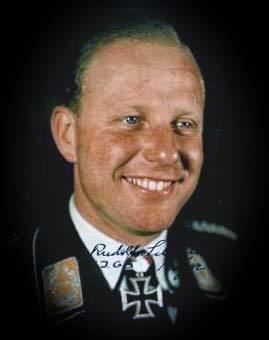Name Rudolf Schoenert | Years of service 1933–45 | |
 | ||
Battles/wars World War IIDefense of the Reich Unit Nachtjagdgeschwader 2, Nachtjagdgruppe 10 | ||
Rudolf Schoenert (27 July 1911 – 30 November 1985) was the seventh highest scoring night fighter flying ace in the German Luftwaffe during World War II. He was also a recipient of the Knight's Cross of the Iron Cross with Oak Leaves. The Knight's Cross of the Iron Cross and its higher grade Oak Leaves was awarded to recognise extreme battlefield bravery or successful military leadership.
Contents
Early life and career
Schoenert was born on 27 July 1911 in Glogau in the Province of Silesia, a province of the German Kingdom of Prussia, today it is Głogów in Poland. On 22 May 1933, he started flight training as a civil pilot with the Deutsche Verkehrsfliegerschule (German Air Transport School) in Braunschweig. From 4 December 1936 to 26 February 1937, he received his recruit training. On 1 April 1937, Schoenert started working as a civil flight instructor.
World War II
After five years in the Merchant Navy, Schoenert began flight training in 1933 and went on to fly commercial aircraft for Lufthansa. He was commissioned as a Leutnant in the Luftwaffe's Reserve in 1938 and in June 1941 joined 4./Nachtjagdgeschwader 1 (NJG 1—1st Night Fighter Wing) at Bergen in northern Holland. He was credited with his first aerial victory on the night of 8/9 July 1941 when he claimed an Armstrong Whitworth Whitley bomber shot down at 02:51 60 kilometres (37 miles) northwest of Vlieland. His total stood at 22 by 25 July 1942 and he was awarded the Knight's Cross.
Schoenert is recognised as the instigator of upward-firing armament in German night fighter aircraft, which he introduced into his own Dornier Do-17 in 1942. The concept, dubbed Schräge Musik (Jazz Music), was initially rejected by Helmut Lent and Werner Streib. Oberfeldwebel Paul Mahle, an armourer attached to II./Nachtjagdgeschwader 5 (NJG 5—5th Night Fighter Wing) at Parchim, worked closely with Rudolf Schoenert and built his own working prototype of Schräge Musik, which was soon fitted to all of the Gruppe's aircraft.
Schoenert claimed the first aerial victory with Schräge Musik in May 1943. By August he was flying with Nachtjagdgeschwader 100 (NJG 100—100th Night Fighter Wing) over the Eastern Front, where he claimed to have shot down 30 Soviet aircraft by early 1944.
On 11 April 1944, Schoenert was awarded the Knight's Cross of the Iron Cross with Oak Leaves (Ritterkreuz des Eisernen Kreuzes mit Eichenlaub), the 450th soldier to receive this distinction. The presentation was made by Adolf Hitler at the Berghof, Hitler's residence in the Obersalzberg of the Bavarian Alps, on 5 May 1944.
Schoenert and Leutnant Karl Schnörrer, Oberst Gordon Gollob, Major Georg Christl, Hauptmann Heinz Strüning, Major Josef Fözö formed the guard of honor at Walter Nowotny funeral at the Zentralfriedhof in Vienna. Nowotny had been killed in action on 8 November 1944. The eulogy was delivered by Generalleutnant Adolf Galland and Generaloberst Otto Deßloch.
During a sortie east of the Elbe on 27 April 1945, an electrical fault rendered Schonert's radar unserviceable and his Junkers Ju 88G was shot down by a Royal Air Force (RAF) de Havilland Mosquito. He survived and was rescued by German troops.
Schoenert survived the war. Schoenert's radio and wireless operator was usually Oberfeldwebel Johannes Richter.
Aerial victory claims
Schoenert was credited with 65 aerial victories claimed in 376 combat missions, including 35 Soviet aircraft on the Eastern Front.
This and the ? (question mark) indicates that the aerial victory claim is not listed by Foreman, Matthews and Parry, authors of Luftwaffe Night Fighter Claims 1939 – 1945.
